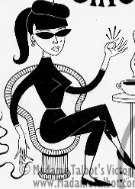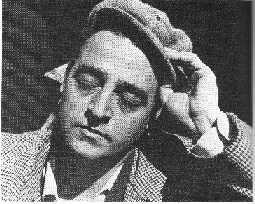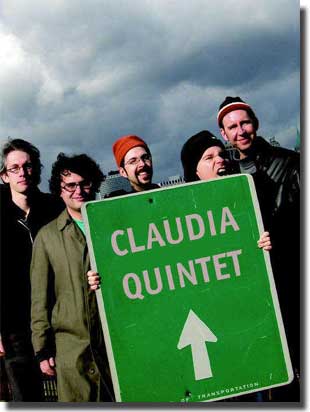 BY ZIVIT SHLANK JAZZ CORRESPONDENT Composer/drummer/bandleader/
BY ZIVIT SHLANK JAZZ CORRESPONDENT Composer/drummer/bandleader/
PHAWKER: What’s the deal with the name Claudia Quintet? Did a mystery woman inspire it?
JOHN HOLLENBECK: A year before the quintet formed, I was in a trio called the Refuseniks with accordionist Ted Reichman and bassist Reuben Radding. We had a steady gig in the East Village every Monday at a club that’s now known as Tonic in NYC. One evening, a young lady named Claudia saw us, and she was very enthusiastic. She said she was going to come back and bring people…she said a lot of things. I pretty much believed everything she said. As soon as we turned away from her, Reuben said, “She’s never coming back.” I was like “What are you serious? She said she would.” She, of course, never came back. She became kind of a myth and we started making up stories about her. Unfortunately around that time, Reuben left the group and thus, the end of the Rufuseniks. It was just Ted and I and we wanted to keep playing. That was how the Claudia Quintet got started…it was an homage to Reuben and the mystery woman. I also thought it’d be interesting to give a feminine name to an all-male band.
PHAWKER: That’s a very interesting way to market your band.
JOHN HOLLENBECK: Haha, well it wasn’t really a marketing thing. It was actually more of a thing considering that jazz, unfortunately, is one of those small worlds dominated by males. The music sometimes kind of gets a little too macho for my taste. So to have that female name serves as a reminder of some other energies, some other ways that we can go. Plus, the actual band sound includes in addition to accordion, bass and drums, a lot of clarinet and vibes, which has an inherently feminine sound, even when we’re playing music that’s slightly more aggressive. So there’s both a serious and a playful basis to the name.
PHAWKER: Moving forward with this latest project What is the Beautiful? How did you first discover the artistry of an unsung hero, Kenneth Patchen [pictured, below right] ?
JOHN HOLLENBECK: I definitely agree with you, he’s unsung for sure. I knew his work a little because I like beat poets, but his name was always under a list of others and you had to dig deep to find his stuff. There are a lot of people that know and love his work. It amazes me that he’s not been talked about enough, both when he was alive and posthumously. We were asked to do this project by the University of Rochester, where there’s been an exhibit of some of his paintings and poems to honor his 100th birthday this year. They thought because of the considerable work he did with jazz musicians, that it would make sense to do a CD and hopefully bring more attention to him. Obviously once I got the offer to do this project, I read as much of his stuff as possible and in the process, really got to appreciate it.
PHAWKER: Being commissioned to create music centered on the words and themes explored by Patchen, what unique challenges did that present to you?
JOHN HOLLENBECK: Well, I tried to use a bunch of different poems because he had such a wide variety. At first, it was too much for me to handle. With some poems I just felt this “Oh, I get this, I understand how he feels or what feelings he’s trying to portray.” In that case, it wasn’t so hard because you just have to be true to the spirit of the poem. With other poems, it was harder because he was intentionally ambiguous or flying around, going back and forth between the absurd or trite, to the very serious and political. What I realized was that it was like hearing different voices. I’d hear one voice, and then I’d hear multiple people talking at the same time. I just read so many poems, and I picked out the ones that gave me ideas instantly, or ones that I knew I could set music to. With a poem there’s form, melody and rhythm already, so my goal was to set it in such a way that would bring out all those elements.
 PHAWKER: Speaking of voices, you managed to recruit the considerable talents of Kurt Elling and a man whom you’ve collaborated with many times, Theo Bleckmann, both providing strikingly different approaches to Patchen’s words. One is very dark and intense, the other sweet and ethereal. In the early stages of conception and creation, did you hear those two voices?
PHAWKER: Speaking of voices, you managed to recruit the considerable talents of Kurt Elling and a man whom you’ve collaborated with many times, Theo Bleckmann, both providing strikingly different approaches to Patchen’s words. One is very dark and intense, the other sweet and ethereal. In the early stages of conception and creation, did you hear those two voices?
JOHN HOLLENBECK: Well, Theo I can hear on almost every project I pursue because he’s so versatile. He can freely improvise, he can use electronics, he can sing beautifully like an instrument, there’s so much he can do. Now with Kurt, I first worked with him on a Fred Hersch project based on Walt Whitman’s Leaves of Grass. I knew already how great he was and is at this kind of thing. I sent him an email asking him if he wanted to do it, and I was surprised at his response. He already knew of Patchen, was a big fan. How the work was divided up was a decision made for me, the recording session date was already set up and could only be done on a certain day. Kurt couldn’t make it to that one, so we had to do his vocals alone. Since he already knew the poems so well, it was a couple takes and Kurt picked out the ones he thought were best. I was able to write the music around his recitations. Then I thought, “Well, what are the pieces we can do live with a vocalist” and those went to Theo. Turned out that decision worked out really great, but I can’t pretend I came up with that idea.
PHAWKER: So for the uninitiated, for those who’ve yet to experience the Claudia Quintet, who’s curiosity of Patchen’s work have been peaked, what can they potentially expect?
JOHN HOLLENBECK: To be honest, I think the music I write is pretty accessible, easy to listen to. It may be structurally complex, but it certainly doesn’t sound it. That’s the main goal. On the flip side, it’s going to be something different than what you’ve heard before.
THE CLAUDIA QUINTET PERFORMS AT 8 PM TONIGHT AT THE PHILADELPHIA ART ALLIANCE, 251 S. 18TH ST. $15
